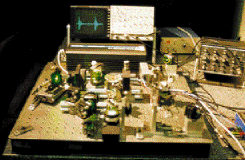Optical Ultrasound Smooths Rough Spots
Susanna Contini HenninkORSAY, France -- Industries use ultrasound in quality assurance and materials analysis, and a new optical technique may simplify the process
for many applications.
Noninvasive ultrasound techniques solve problems in the aerospace and automotive industries, detecting mechanical flaws or defects such as cracks, porosity or weaknesses in metal. They also measure the thickness, temperature, microstructure or hardness of materials such as metals, ceramics, composites, opaque polymers and semiconductors. Although piezoelectric transducers offer a high degree of accuracy, the need for surface contact makes them unsuitable for use in online production or inspection of materials at high temperatures.

Though still in the prototype stage, holographic dynamic interferometers are proving valuable in measuring ultrasonic vibrations on rough surfaces. |
However, optical ultrasound detectors have had limitations: They require polished surfaces or filtering of the scattered laser light, which reduces their sensitivity by several orders of magnitude.
Explosive interferometry
An international team of scientists has used photorefractive crystals to develop a holographic dynamic interferometer that can measure ultrasonic vibrations of rough surfaces. A French team was led by Gerald Roosen, director of research of the Photorefractive Non-Linearity Group of the Centre National de Recherche Scientifique's (CNRS) Theoretic and Applied Optics Institute in Orsay; a Canadian group was led by Jean-Pierre Monchalin of the Industrial Materials Research Institute of the Canadian National Research Center in Boucherville.
Using holographic dynamic materials such as cadmium telluride photorefractive crystals (synthesized in the laboratory of Jean-Claude Launay of the CNRS in Bordeaux) allows for a large field of vision. The photorefractive sensor efficiently can collect and use all the light scattered by a rough object.
Sensors based on Fabry-Perot interferometery (used in laser ultrasonic systems that inspect airplanes) can be used for rough surfaces, but the photorefractive device is smaller and more sensitive at frequencies below 10 MHz and significantly more sensitive below 2 MHz. It is insensitive to low-frequency vibrations (<10 kHz) that the industrial environment frequently produces. The photorefractive sensor also can easily eliminate laser intensity fluctuations, Roosen said.
The photorefractive ultrasonic sensor will find applications in the aeronautics, automotive, semiconductor, steel and petroleum industries, among others.
The interferometer is being produced by UltraOptic Inc. of Canada. The French company SFIM ODS, which has been involved in real-time, nondestructive laser ultrasonic testing of laser welds, industrial ceramics and applications in the food industry, also intends to use the sensor, Roosen said.
LATEST NEWS
- Exail Signs LLNL Contract, Partners with Eelume Apr 26, 2024
- Menlo Moves U.S. HQ: Week in Brief: 4/26/2024 Apr 26, 2024
- Optofluidics Platform Keys Label-, Amplification-Free Rapid Diagnostic Tool Apr 25, 2024
- DUV Lasers Made with Nonlinear Crystals Enhance Lithography Performance Apr 25, 2024
- Teledyne e2v, Airy3D Collaborate on 3D Vision Solutions Apr 24, 2024
- One-Step Hologram Generation Speeds 3D Display Creation Apr 24, 2024
- Innovation Award Winners for Laser Technology Honored in Aachen Apr 23, 2024
- Intech 2024: AI Arrives on the Shop Floor Apr 22, 2024
